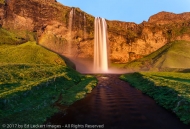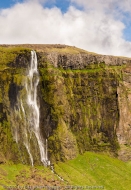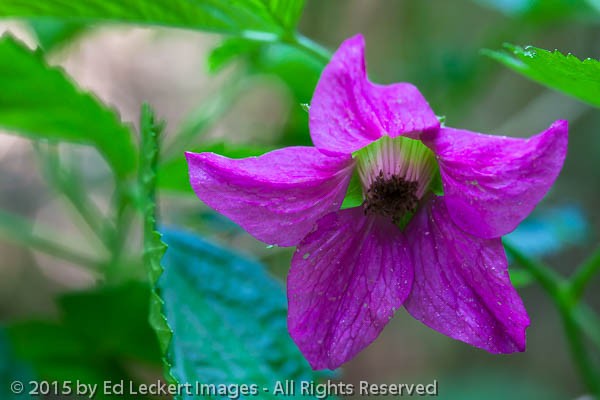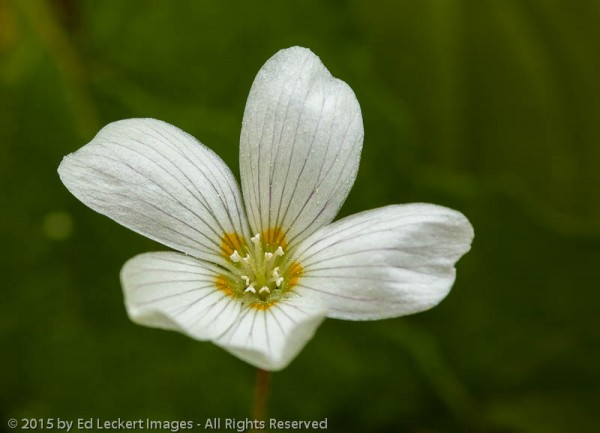


Last week we talked about my visit to the Hoh Rain Forest, a temperate rain forest on the western edge of the Olympic Peninsula of Washington State in the Olympic National Park. The stars of the show are the old growth trees and the mosses that hang from them, but let’s not overlook the understory and the wildflowers that grow there.
While I’m getting ready for a photo trip, loading maps onto my GPS, charging my camera batteries, and digging out the appropriate camping gear, one of the things that’s on my mind is which lenses to take with me. If I’ll be walking a long distance from my car, such as on a backpacking trip, I can only carry so much, so I have to be selective. But one lens that almost always gets in my pack is the macro lens, the one I use for wildflowers and other close-ups. There are other tools in my arsenal to shoot close-ups, but macro lenses are designed not only to focus really close, but also are optimized to shoot objects in a flat plane, where the distance from the front to the back of the subject is relatively small. So naturally, this is my go-to lens for shooting small wildflower close-ups.
Wildflowers grow on their own terms, and what you see depends on the area, altitude, weather, and time of year, among other things. Not being intimately familiar with the Hoh, I didn’t know exactly what to expect, but I knew wildflowers would be out and I wanted to be prepared.
As a photographer who publishes images of wildflowers, I am expected to know what it is I’m photographing and be able to caption and keyword the images. Well, that’s easier said than done. I’m not a botanist, but I have been through the Seattle Mountaineers Introduction to the Natural World course (which is excellent, by the way), and I own several field guides such as Turner and Gustafson’s “Wildflowers of the Pacific Northwest” and a stack of pocket field guides. But that will only get you so far, since there are so many varieties that look very similar, and they don’t always look like the picture in the book, depending on their age and other factors. In fact, I’ve been on naturalist-oriented hikes with the Mountaineers and watched experienced leaders argue for twenty minutes, field guides in hand, as to what exactly they’re looking at as they stand over a wildflower. They always come away with a consensus, which is a great help to me when I’m keywording my images, but how do I know they’re right?
Yes, I know this isn’t the biggest problem the world has today, but if I’m going to go to the trouble of labeling something, Latin name and all, and then publish it in various ways, I think I have a responsibility to know what I’m talking about, or I should keep my opinion to myself. When I go running around the Internet for help with plant identification, I hope the people who captioned the pictures I’m looking at were diligent about their process, and I feel I should do the same. So to a certain degree, keywording my wildflower images stresses me out. Some are obvious, others not so much. So I do the best I can, and if I can’t be relatively sure, I don’t drop a name on the image.
For example, this one is pretty easy. It’s bunchberry, or dwarf dogwood. Nothing else really looks like it. I’ve seen it before. I feel pretty confident putting a label of Cornus unalaschkensis on it. Wouldn’t you?

A buncherry plant grows on the floor of the Hoh Rain Forest, in the Olympic National Park, Washington.
Or this one, for example. The salmonberry blossom is unique, and grows on a shrub that can grow up to 15 ft. (4.5 m.) high, as opposed to near the ground. So it’s a gimme.

A salmonberry blossom means salmonberries are not far away, in the Olympic National Park, Washington.
But it gets harder. A lot harder. I’ve gone back and forth on this next one, and one that looks very similar? I’m pretty sure it’s Redwood sorrel, also known as wood sorrel or Oregon oxalis. “Common, all spring and summer…Coastal, west-side forest.” Yes! That’s a good start. “Leaf divided into 3 heart-shaped leaflets.”
OK, so I usually get so busy shooting the flowers and trying my best to blur out everything else in the background that I don’t get any photos showing the leaves, stems, and overall plant, which leaves me without vital information when reading these descriptions in the field guides. But this time I did get more “context” shots, including the leaves, and it’s looking like a match. “Flowers solitary on long stalks…” Check. “…white to pink…often with darker pinkish red veins.” Check. Native to the Olympic National Park. Check. So is it Oxalis oregana? I think so. I’ve checked it against the photo in the field guide. I’ve done a Google search and checked it against photos on Wikipedia, the U.S. Forest Service, and wildflower.org, among others. I’m pretty sure. I’m going with it!

Redwood sorrel, or Oregon oxalis, grows on the edge of the Hoh River Trail, in the Olympic National Park, Washington.
OK, next up is a pretty little yellow flower – looks like some kind of orchid to me, but what do I know. Looking in the “Yellow Flowers” section under “5 irregular petals”, I see a bunch of violets that are similar in appearance. There’s the Douglas’s violet, the Smooth yellow violet, the Pine violet, the Roundleaf violet, the Prarie violet, the Goosefoot violet, the Evergreen violet, and finally, the Shelton violet that all look like it. Friggin’ really? How in the heck am I supposed to narrow this down? And by the way, shouldn’t a violet be, well, violet, and not yellow? Who makes up this stuff, anyway?

A Smooth yellow violet, or stream violet, grows along the Hoh River Trail, in the Olympic National Park, Washington.
Well, first I look at the maps in the field guide and eliminate those that aren’t supposed to be growing on the western side of the Olympic Peninsula. Now flowers don’t always stay put where field guide authors say they should be, but geez, I have to start somewhere. So that gets us down from eight to three. That’s huge! OK, now what? Well, Smooth yellow violet and Roundleaf violet are common, whereas Evergreen violet is uncommon, so that’s a mark against the Evergreen, but I can’t count him out. What else?
Well, I have pretty good photos of the leaves, so let’s look at them. “Heart-shaped, with sharp tips, entire or with small teeth” for the Smooth guy. Could be. “Basal leaves on long stalks are thin, round, with scalloped edges and rounded lobes at base of leaf blade” is the Roundleaf’s description. Hmm, I don’t like the basal part. I don’t have a great photo of the entire plant, but I don’t think the leaves are that far down from the flower, or at the base (basal). So Roundleaf is not winning any points with me. “Shiny evergreen leaves thick, heart-shaped, with pointed tips, spotted purple underneath” is Evergreen’s story. Well, the leaves in my image look to be on the thick side, and while I didn’t turn them over and photograph their bottoms, I can almost make out some purple spilling around the edges. Are is that just dark green?
What about the flowers? Smooth: “Flower dark yellow with maroon veins on 3 lower petals. The 2 side petals are bearded; lowest petal is spurred.” Ah hah! The Roundleaf has no bearded petals, and the Evergreen has a rounded lower petal, not a spurred one. I think that settles it! This must be a Smooth yellow violet, or Viola glabella! I’m 100% sure that it might possibly be!
So that’s how it goes every time I bring home images of wildflowers. Sometimes it’s a breeze to identify them, and sometimes I never figure it out. But I think when you’re out in nature, it’s good for the soul to stop and take time to see what’s around you, not just blast to the end of the trail and back at top speed. Photographing and trying to identify wildflowers, some so tiny that most people wouldn’t even notice them if they looked straight at them, helps me to connect more with nature when I’m out there. And after all, isn’t that why we spend time out there, to connect to something that’s lost to us in our fast-paced city lives?
So next time you go on a hike, backpack, or nature walk, slow down and look around you at the wildflowers that are growing quietly at your feet. When you really start looking, you’ll be amazed at what you find!

Thank’s Ed for the lovely photos and info on wild lowers. I’m sure I would not be able to identify by name, so I feel “A wild flower by any other name would still be a wild flower!!